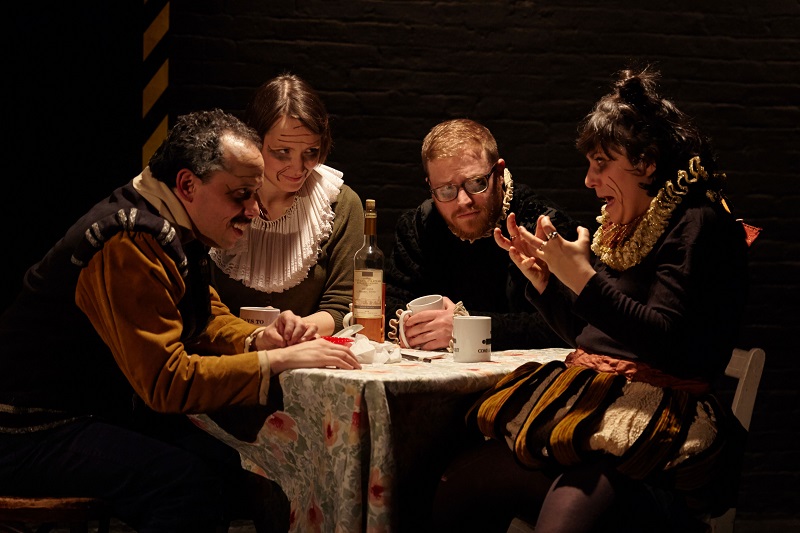
The average person probably has at least a passing familiarity with William Shakespeare's Hamlet. But how is it different to know the Western canon's arguably most famous tragedy from the inside, so to speak? And can that shift in perspective, even if observed rather than experienced directly, allow the audience to see the play afresh, with different eyes? In John Kurzynowski and Jon Riddleberger's metatheatrical comedy How to Hamlet, or Hamleting Hamlet, created and performed by Theater Reconstruction Ensemble (TRE), a quartet of people (Nathaniel Basch-Gould, Sam Corbin, Joshua William Gelb, and Emily Marro) find themselves unexpectedly performing Hamlet (a problem, one would imagine, that most of us are glad not to encounter). TRE is a collective that seeks to "reconstruct both classical and canonical forms of theatricality through the playful development of works over time," and How to Hamlet uses a play centered on revenge, madness, and an existential crisis as the basis for unpredictable fun. To borrow from Troilus and Cressida, "this is, and is not," Hamlet.
Early on in their conscription, the performers themselves ask each other what is essentially "Hamlet" (or "Hamlet") about Hamlet (or Hamlet). They refresh themselves -- and the audience -- on the plot and do a very brief bit of dramaturgy, and then it is off to the rotten state of Denmark. Having many of the mechanics of staging exposed to audience view does interestingly highlight how little it takes to transport spectators into the world of a play -- dim lighting, some fog, and some minimal costuming, even in a comedy, has the desired effect. Throughout, the performers sometimes employ language from Hamlet and sometimes paraphrase or summarize it (many times to hilarious effect). Which is Hamlet in its essential state? Both? Neither? At one point, the performers get stuck in a loop while running their lines, perhaps in a nod to Tom Stoppard's Rosencrantz and Guildenstern, endlessly repeating their roles as minor characters, or perhaps pointing to the fate of any theatrical character. There is also, appropriately enough, a ghostly element at play, seemingly a kind of possession, which simultaneously gives the actors some great comedic opportunities and works as metaphor for how stories survive and change form, possess us and are possessed by us. In one of How to Hamlet's more serious moments (the other being a discussion of Ophelia's death that finds the male and female performers on opposing sides of the stage), the production extends Hamlet's Act 2 allusion to the deadly encounter between Pyrrhus and King Priam. In doing so, it underscores such narrative repetition-with-a-difference, even repurposing one of those of-quoted lines from Hamlet, thereby calling attention to the mutations of older stories into newer forms, of old plots given new faces. As Nathaniel Basch-Gould, who is telling the story, says, those who saw the event never forgot it. And now, mediated through Shakespeare and TRE, among others, it becomes part of our memories as well.
How to Hamlet, or Hamleting Hamlet is a clever exploration of the theatrical tradition accomplished through some really entertaining verbal and physical comedy. One masterfully intensifying segment, for example, finds Sam Corbin having to cross and re-cross the stage while being stage managed by Joshua William Gelb (who, in life imitating art imitating life, conceived and directed the similarly meta revival of the nineteenth-century melodrama The Black Crook this past fall) and trying not to disrupt the production. All of the cast members shine as both the convincingly down-to-earth performers and the more exaggerated Shakespearean characters (Emily Marro does an excellent parodic Polonius possession). You don't have to be a Shakespeare expert to experience How to Hamlet's comic alchemy: just let it possess you. - Leah Richards & John Ziegler
